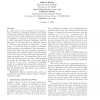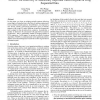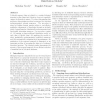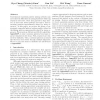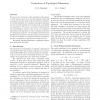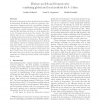SDM
2003
SIAM
15 years 2 months ago
2003
SIAM
This paper presents a general framework for adapting any generative (model-based) clustering algorithm to provide balanced solutions, i.e., clusters of comparable sizes. Partition...
116
click to vote
SDM
2003
SIAM
15 years 2 months ago
2003
SIAM
In earlier work we have introduced and explored a variety of different probabilistic models for the problem of answering selectivity queries posed to large sparse binary data set...
143
click to vote
SDM
2003
SIAM
15 years 2 months ago
2003
SIAM
In this paper, we focus on mining periodic patterns allowing some degree of imperfection in the form of random replacement from a perfect periodic pattern. In InfoMiner+, we propo...
SDM
2003
SIAM
15 years 2 months ago
2003
SIAM
A lack of power and extensibility in their query languages has seriously limited the generality of DBMSs and hampered their ability to support data mining applications. Thus, ther...
102
click to vote
SDM
2003
SIAM
15 years 2 months ago
2003
SIAM
A labeled sequence data set related to a certain biological property is often biased and, therefore, does not completely capture its diversity in nature. To reduce this sampling b...
115
click to vote
SDM
2003
SIAM
15 years 2 months ago
2003
SIAM
Serial criminals are a major threat in the modern society. Associating incidents committed by the same offender is of great importance in studying serial criminals. In this paper,...
SDM
2003
SIAM
15 years 2 months ago
2003
SIAM
122
click to vote
SDM
2003
SIAM
15 years 2 months ago
2003
SIAM
Conventional sequential pattern mining methods may meet inherent difficulties in mining databases with long sequences and noise. They may generate a huge number of short and trivi...
103
click to vote
SDM
2003
SIAM
15 years 2 months ago
2003
SIAM
We present two extensions of the algorithm by Broomhead et al [2] which is based on the idea that singular values that scale linearly with the radius of the data ball can be explo...
107
click to vote
SDM
2003
SIAM
15 years 2 months ago
2003
SIAM
We study the interaction between global and local techniques in data mining. Specifically, we study the collections of frequent sets in clusters produced by a probabilistic clust...

